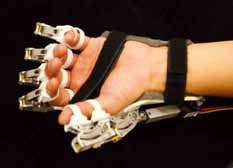Hand Robot - a revolution of stroke therapy

Jointly developed by Dr Raymond Tong Kai-yu, Associate Professor of the Department of Health Technology and Informatics, and the Industrial Centre, this Exoskeleton Hand Robotic Training Device works to recover the hand functions of stroke patients. It is made up of an embedded controller and a robotic hand module, which provide patients with assistive power to perform hand movements and gradually boost relearning in the brains of stroke patients.
One the compact, wearable robotic hand is attached to the patient’s fingers and hand, it begins to detect his or her intention to move through signals from the hemiplegic side measured by surface electromyography. A nervous response then set the robotic hand in motion to move the patient’s stiff hand at his or her own will. The device affords substantial flexibility, as each finger assembly can be adjusted to fit different finger lengths.
Unlike the case with conventional rehabilitation treatment, the assistive power from the robotic hand helps to overcome muscle and joint stiffness, thus allowing the patient to open/close a paralysed hand or pick items up according to his or her own intention. Through repetitive exercises, the hand motions send feedback to the patient’s brain, helping it to rewire itself in response to new experiences.
The device has been licensed to the Deltason Medical Group, and clinical trials are well underway at the Shatin Hospital and Kowloon Hospital. It also won a Gold Medal at the 62nd International Trade Fair Ideas – Inventions – New Products in Nuremberg, Germany.
This article was first appeared on the PolyU Milestone, June 2011 Edition
Provided by ResearchSEA


















